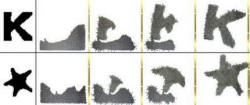|
 Rise
of the machines? Tiny robot horde swarms to form shapes Rise
of the machines? Tiny robot horde swarms to form shapes
 Send a link to a friend
Send a link to a friend
[August 15, 2014]
By Will Dunham
WASHINGTON (Reuters) - They look vaguely
like miniature hockey pucks skittering along on three pin-like metal
legs, but a swarm of small robots called Kilobots at a laboratory at
Harvard University is making a little bit of history for automatons
everywhere.
|
|
 Researchers who created a battalion of 1,024 of these robots said
on Thursday the mini-machines are able to communicate with one
another and organize themselves into two-dimensional shapes like
letters of the alphabet. Researchers who created a battalion of 1,024 of these robots said
on Thursday the mini-machines are able to communicate with one
another and organize themselves into two-dimensional shapes like
letters of the alphabet.
Much smaller groups of robots have been able to carry out similar
tasks, but never a group this size.
The Kilobots are told by the researchers via an infrared transmitter
to do a certain job. The robots then do it collectively without
further input from a human being.
In a study published in the journal Science, they formed themselves
on a large tabletop into the shapes of the letter "K," a star, a
solid square and a wrench.
It may be a step forward for collective artificial intelligence,
although the researchers acknowledge the Kilobots are not exactly
thinking deep thoughts.

"This is a 'collective' of robots - a group of robots that work
together to complete a common goal," said Harvard computer scientist
Michael Rubenstein, who led the study. "If you call collective
artificial intelligence the ability of a 'collective' to start to
behave as a single entity, you could call this collective artificial
intelligence."
The Kilobots are simple and inexpensive robots built to talk to
fellow Kilobots and sense the location of those others using
infrared light. They use vibration motors to slide across a surface
on their three legs.
But the surface must be very smooth. The one used in this study was
essentially an eight foot (2.4 meter) by eight foot "dry erase"
board tabletop. Even minor surface friction like that of paper halts
them.
The robots measure about 1.2 inches in diameter and two inches tall.
The material to build each of them cost just $14.
[to top of second column]
|

Rubenstein said the research anticipates a day when people may send
many robots acting as a single entity to perform a task - perhaps to
a destination like Mars - instead of humans or a single robot.
A "collective" may better handle an unknown environment - for
example, forming into a snake shape to navigate sand dunes or like a
ball to roll down a hill. He said a "collective" also is "fault
tolerant" - if a single robot among 1,000 breaks down, plenty are
left to do the job.
The Kilobot name is a play on the word kilobit, meaning 1,024 bits
of digital information. But to some it might sound menacing - as in
"killer robot" - as if it belongs in a movie like "Terminator 3:
Rise of the Machines."
"I tell people that these robots are not very dangerous. The only
way that they could hurt you is if you try to eat one. They can't
even go over a piece of paper. So they're kind of stuck where they
are," Rubenstein said.
(Reporting by Will Dunham, editing by G Crosse)
[© 2014 Thomson Reuters. All rights
reserved.] Copyright 2014 Reuters. All rights reserved. This material may not be published,
broadcast, rewritten or redistributed.
 |